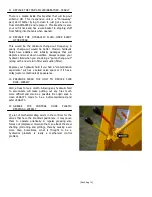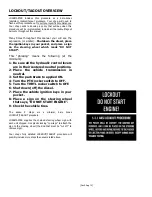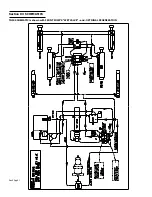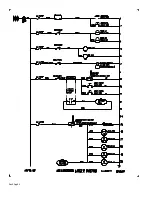
2
CHECK THE OIL TANK’S FILL LEVEL…DAILY
The tank has a sight level gauge that is used to confirm
the correct amount of hydraulic fluid is in the system.
Checking procedure:
1-
Retract the ejector blade fully forward towards cab.
2-
Tailgate fully lowered closed and latched.
3-
The slider cylinders must be fully retracted (slider fully up)
and sweep cylinders fully retracted (sweep rotated up).
4-
PTO disengaged (diesel can be on or off).
5-
Now read the tank’s fill level gauge. The amber colored
hydraulic oil’s level should be visible
6-
Fill to the upper black line (with all cylinders retracted).
DO NOT
OVERFILL
THE TANK. Oil will spray out of the
tank’s filler/breather if overfilled.
Be certain to position the ejector, tailgate, and compact
blades are as described above
before
sighting the
gauge. This will position the “cylinders” to assure you do
not overfill.
Use a name brand hydraulic fluid in an AW46 grade
whenever you add fluid.
3
CHECK THAT THE SUCTION LINE VALVE (GATE
VALVE) IS FULLY OPEN…DAILY
The leverarm of the full-port ball valve must be “parallel”
to its body to be fully open
4
CHECK
THE
“PLUMBING”
FOR
EXTERNAL
LEAKS…DAILY
Hydraulic fluid is flammable and messy. When fluid is on
the shop floor or on the LEGACY3 it can cause injuries
from slipping and falling. Inspect the LEGACY3’s various
fittings, hoses, tubes for any evidence of oil escaping.
Often by retorquing the hose end or fitting you can stop
the leakage. Sometimes a hose or fitting will need to be
replaced.
5
CHECK THE PUMP AND VALVES FOR EXTERNAL
LEAKAGE…DAILY
The LEGACY3 uses “0-ring boss” ports on all the valve
ports and the pump. Leakage here is usually going to be
correctable by retightening the attached fittings. In
some rare cases the o-ring may be nicked or extruded,
replace the o-ring or install fresh fitting. The valves have
a group of o-rings seals between their cast sections. If
oil seems to be weeping out between sections, try to re-
torque (evenly) the valve tie-rod bolts first (loosen
valve’s mounting foot bolts first). The pump has a seal
on its input shaft that could eventually weep oil. This
must be replaced if this is happening.
The most difficult job in fixing a leak is identifying where
the oil is
really
escaping. Gravity, road travel blow-age,
etc can fool you into misidentifying. If in doubt, wash
area and keep looking until confident.
6
CHECK THE ROD CYLINDERS FOR EXTERNAL
LEAKAGE…DAILY
Rod cylinders have a bearing and seal system where the
rod itself leaves the barrel. Repair if leakage occurs
here.
7
INSPECT THE STEEL TUBE RUNS FOR DAMAGE AND
LOOSE CLAMPING…DAILY
If a tube is impacted, it may become damaged. Check
for this. Replace damaged tube so they do not rupture
later.
8
CHECK FOR A FULLY CHARGED, ACCESSIBLE FIRE
EXTINQUISHER…DAILY
Hydraulic fluid is flammable and could ignite if it sprays
upon the diesel’s hot exhaust surfaces.
9
INSPECT THE HOSES FOR ABRASIONS, RUB
SPOTS,ETC…DAILY
Identifying possible hose weaknesses and repairing
them promptly will reduce the possibility of a hose burst
later on.
10
REPLACE
THE
IN-TANK
SUCTION
STRAINER…YEARLY
Near the floor of the oil-tank (submersed) is the suction
filter/strainer. Whenever the tank has been drained of oil
(for whatever reason), remove this filter and replace it
(or clean it if in otherwise good condition). Make sure
the 3-PSI bypass valve is “free” and will fully seat
closed.
[Sec02-pg12]
Содержание LEGACY 3 Series
Страница 13: ...Sec02 pg04 1 2 3 5 6 6 7 9 17 16 18 20 21 8 11 15 19...
Страница 17: ...Sec02 pg08 1 5 8 7 9 6 13...
Страница 19: ...sec02 pg10 1 2 3 4 9 10 12 14...
Страница 24: ...Section 03 SCHEMATICS THIS SCHEMATIC is shown with FRONT PUMP S WET VALVE and OPTIONAL REGENERATION Sec03 pg01...
Страница 25: ...Sec03 pg02...
































